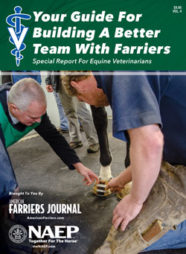Last year, a younger farrier rode in Tom Trosin’s shoeing truck. While chatting between stops, the junior horseshoer identified one aspect of farriery that the Oklahoma farrier excels at — and it has nothing to do with trimming and shoeing.
“He told me, ‘You say goodbye better than anybody I’ve met,’” recalls Trosin, a farrier for more than 35 years. He said, “When we leave a barn, you not only have the check, but they know what you did, they know why you did it. They know when you’re coming back and that you can be counted on if there’s a problem.”
Trosin appreciates the compliment, but explains his communication with clients isn’t simply about how he leaves a barn. Instead, any time he is on the phone or with a client, it is time to gather information that will benefit the client’s horse and Trosin’s business management. When he shared his communication approach at the 2021 American Farrier’s Association (AFA) Annual Convention, Trosin stressed he isn’t dictating how others should operate their businesses. Instead, consider how his communication supports how he wants to operate his farrier practice.
Direct Communication Remains Best
Through innovations like the atmospheric propane forge and adhesives, farriers have benefited from many advancements developed over the past half-century. Trosin argues that among these, the most impactful is the smartphone. Looking back at communication during his early career, Trosin says farriers relied on address books and pay phones, or following up with a client at the end of the day after listening to an answering machine recording left hours prior.
Farrier Takeaways
- Messaging apps give clients greater access to you, which opens you to more frequent and potentially unwelcome client communication.
- Direct communication with clients allows for more questioning to draw out more information on their horses.
- Tone can be difficult to read in a client’s text message, so be careful how you interpret it.
Not only does the smartphone give instant communication, but also additional tools for text messaging and business management. As much as these revolutionary tools deliver a competitive edge, Trosin still finds direct communication more beneficial for farriers. Over the phone or face-to-face, he says it is crucial to treat client interactions as an opportunity to gather more information.
“When I speak with a client, we’re going to have a conversation about their horse. We’re going to have a conversation about what they want, what their needs are. Is there any issue with the horse if they are planning on roping over the weekend? I need to know these things,” says the former president of the AFA.
Some farriers may favor less communication, or a reliance on text messaging, Trosin hesitates to criticize that approach, reiterating that he isn’t dictating how one should manage a business. However, Trosin feels if he doesn’t invest the time with each client, he can do his job to the best of his ability.
“I need to know these things because if I don’t, I get hamstrung,” he says.
The issue Trosin finds with messaging platforms is that the interactions leave an incomplete picture. Messaging is easier, and less of a time commitment, but the detail is easily lost. Trosin finds that he is more apt to ask important follow-up questions when speaking directly with a client. To illustrate this, he shared an example of how an incomplete picture becomes disruptive for a farrier. A farrier friend across the border in Texas took on an account after a text from a prospective client who had three horses. The Lone Star State farrier failed to ask any questions about the horses. At the appointment, he found a Thoroughbred, which was a straightforward case. However, the second and third horses were an Arabian with a stifle issue and a draft horse, respectively. The draft horse came at a higher rate, which was a discussion point on-site with the client. A prior conversation could have benefited the situation before going to the barn.
“He didn’t talk to the client, but took that job on a text,” he says. “When I speak with a prospective client I need to know what they need to know. I need to know who they are. Can we meld together? I’ve always had wonderful clients by making communication a focus.”
Trosin adds that this initial discussion is when you begin dictating your expectations of clients. Future interactions are opportunities to reinforce. You communicate to set the tone of the business relationship. Be thorough in explaining how you operate your practice. Determine whether you match well with this person and want to work with their horse.
Varied communication apps like Messenger or WhatsApp are a double-edged sword, as they increase your accessibility, which clients and prospective clients will use according to their needs rather than your rules. Trosin limits how clients can contact him.
“Make rules for your clients and stick to those rules…”
“Just know that you’re opening yourself up. I had one potential client reach out to me on Facebook,” he says. “I told her to give me a phone call. She replied, ‘Well, I prefer to use Facebook Messenger.’ I said, ‘Well, you’re going to have to prefer a different farrier.”
Direct communication helps when answering client questions or correcting their behaviors. Trosin says to never miss the opportunity to educate a client.
“Train your clients. Educate your clients,” he says.
Another problem with text-based messaging apps is that they lack tone. Incorrectly reading tone might lead you to replying in an unprofessional manner. Or the state in which you read an email affects your interpretation, such as working with a rank horse, then immediately viewing a text message. The negativity from the experience with the horse could lead to a negative interpretation of an email that was intended otherwise. This is projection, or displacing your feelings onto another person. To better understand this and how it applies to your client interactions, Trosin recommends the 1978 book The Road Less Traveled by Scott Peck. In this book, the author explains how the mood you are in affects how you perceive others and, in turn, communicate with them.
By communicating over the phone, there is less misinterpretation of tone, as it is easy to understand the mood of the client at the time. But if you communicate through texting, read the message from a positive perspective. Trosin finds this makes reading a negative tone from the client less likely. It also reinforces why direct prior communication with a client is essential. By understanding that client’s personality, you’ll recognize their typical mood when approaching you.
Other times, the client’s texting tone will be unmistakably negative. Where in person, over the phone or over texting, Trosin says to remain professional and don’t respond angrily.
“When you interact with people, you get more flies with honey than you do with vinegar,” he says. “Even when I’m about to fire one, I fire them politely. I will say, to effect, this isn’t working out. ‘I can tell you’re not happy, and something’s not right in this relationship. I want you to get somebody you’re more comfortable talking to or working with.’” He adds that repairing a client relationship prior to firing is more likely through direct communication rather than through messaging.
“If you have ever succeeded at arguing with a client, trainer, veterinarian or a horse, then come see me and tell me how to do it,” he adds. “I’ve never won an argument, especially with a horse. Let’s politely find common ground.”
Overall, Trosin looks at communication as an aspect of operating as a professional. Part of this is identifying boundaries with clients, including the communication means and availability you offer to your clients. Consider other professions, such as veterinarians or human medicine specialists. Rarely can the client directly text those professionals. Instead, they either call an office or speak face-to-face during a scheduled appointment. Although an office line isn’t plausible for most farriers, should clients expect immediate and direct communication with farriers? They will unless you establish those boundaries with your clients, according to Trosin.
“It all starts with our level of professionalism,” he says. “Make rules for your clients and stick to those rules. The client can’t text the veterinarian, they have to call the clinics for the most part. I can’t text my hip surgeon. Professionalism starts with a personal decision and to state, ‘These are my hours.’ Farriers have to have a level of communication that is suitable for their businesses and lives. This trade is hard enough on us.”








